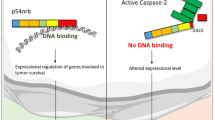Abstract
Abundant levels of the hyperactive low molecular weight (LMW) forms of cyclin E contribute to deregulation of Cdk2 in breast tumors, but the mechanism through which they arise is not fully understood. Here, we explored the hypothesis that post-translational processing by a protease generates the LMW forms of cyclin E in breast tumors. In ZR75 tumor cell lysates, calcium-induced cyclin E truncation into peptides corresponding in size with LMW forms of cyclin E in tumor tissues. Calpeptin inhibited calcium-stimulated cyclin E truncation, indicating that cleavage resulted from activity of the calcium-dependent protease, calpain. Consistently, calcium+calpain caused truncation of cyclin E immunoprecipitated from tumor cells and tissues. Calcium also caused truncation of the calpain regulatory subunit in tumor cell lysates, indicating that elevated calpain activity accompanies cyclin E truncation. Increased levels of the calpain small subunit were also observed in breast tumors, and significant amounts of its proteolyzed forms indicated increased calpain activity. While elastase also caused cyclin E truncation, the cleavage pattern was distinct from that generated by calpain, suggesting discrete mechanisms in regulating the formation of LMW cyclin E in breast tumors. Treatment of ZR75 cultures with calcium+A23187 recapitulated the formation of the calcium/calpain-induced LMW forms of cyclin E. Altered calcium homeostasis and/or inability of the endogenous calpain inhibitor to control the activity of high levels of the calpain small subunit may contribute to increased calpain activity in breast tumors, causing abundant levels of LMW cyclin E.
This is a preview of subscription content, access via your institution
Access options
Subscribe to this journal
Receive 50 print issues and online access
$259.00 per year
only $5.18 per issue
Buy this article
- Purchase on Springer Link
- Instant access to full article PDF
Prices may be subject to local taxes which are calculated during checkout




Similar content being viewed by others
References
Bradford MM . (1976). Anal. Biochem., 72, 248–254.
Buckley MF, Sweeney KJ, Hamilton JA, Sini RL, Manning DL, Nicholson RI, deFazio A, Watts CK, Musgrove EA and Sutherland RL . (1993). Oncogene, 8, 2127–2133.
Croall DE and DeMartino GN . (1991). Physiol. Rev., 71, 813–847.
Dou QP, Pardee AB and Keyomarsi K . (1996). Nat. Med. 2, 254.
Ford HL, Kabingu EN, Bump EA, Mutter GL and Pardee AB . (1998). Proc. Natl. Acad. Sci. USA, 95, 12608–12613.
Harwell RM, Porter DC, Danes C and Keyomarsi K . (2000). Cancer Res., 60, 481–489.
Hinds PW, Mittnacht S, Dulic V, Arnold A, Reed SI and Weinberg RA . (1992). Cell, 70, 993–1006.
Kawasaki H and Kawashima S . (1996). Mol. Membr. Biol., 13, 217–224.
Keyomarsi K, Conte D, Toyofuku W and Fox MP . (1995). Oncogene, 11, 941–950.
Keyomarsi K and Herliczek TW . (1997). Prog. Cell Cycle Res., 3, 171–191.
Keyomarsi K and Pardee AB . (1993). Proc. Natl. Acad. Sci. USA, 90, 1112–1116.
Lee SW, Tomasetto C, Swisshelm K, Keyomarsi K and Sager R . (1992). Proc. Natl. Acad. Sci. USA, 89, 2504–2508.
Lelekakis M, Moseley JM, Martin TJ, Hards D, Williams E, Ho P, Lowen D, Javni J, Miller FR, Slavin J and Anderson RL . (1999). Clin. Exp. Metastasis, 17, 163–170.
Nielsen NH, Arnerlov C, Emdin SO and Landberg G . (1996). Br. J. Cancer, 74, 874–880.
Ohtsubo M, Theodoras AM, Schumacher J, Roberts JM and Pagano M . (1995). Mol. Cell. Biol., 15, 2612–2624.
Porter DC, Zhang N, Danes C, McGahren MJ, Harwell RM, Faruki S and Keyomarsi K . (2001). Mol. Cell Biol., 21, 6254–6269.
Said TK and Medina D . (1995). Carcinogenesis, 16, 823–830.
Saido TC, Sorimachi H and Suzuki K . (1994). FASEB J., 8, 814–822.
Sewing A, Ronicke V, Burger C, Funk M and Muller R . (1994). J. Cell Sci., 107, 581–588.
Shiba E, Kambayashi JI, Sakon M, Kawasaki T, Kobayashi T, Koyama H, Yayoi E, Takatsuka Y and Takai SI . (1996). Breast Cancer, 3, 13–17.
Steeg PS and Zhou Q . (1998). Breast Cancer Res. Treat., 52, 17–28.
Acknowledgements
We thank Dr Martha Stampfer for providing the breast tumor tissues and HMEC, and Deirdre Lobb for technical assistance. This work was supported by an operating grant from the Canadian Institutes of Health Research to KYL, an Alberta Heritage Foundation for Medical Research Scholar.
Author information
Authors and Affiliations
Corresponding author
Rights and permissions
About this article
Cite this article
Wang, X., Rosales, J., Magliocco, A. et al. Cyclin E in breast tumors is cleaved into its low molecular weight forms by calpain. Oncogene 22, 769–774 (2003). https://doi.org/10.1038/sj.onc.1206166
Published:
Issue Date:
DOI: https://doi.org/10.1038/sj.onc.1206166
Keywords
This article is cited by
-
ASPM regulates symmetric stem cell division by tuning Cyclin E ubiquitination
Nature Communications (2015)
-
IL-17A and its homologs IL-25/IL-17E recruit the c-RAF/S6 kinase pathway and the generation of pro-oncogenic LMW-E in breast cancer cells
Scientific Reports (2015)
-
Limoniastrum guyonianum aqueous gall extract induces apoptosis in colorectal cancer cells by inhibiting calpain activity
Tumor Biology (2014)
-
The calpain system and cancer
Nature Reviews Cancer (2011)
-
Calpain Plays a Central Role in 1-Methyl-4-phenylpyridinium (MPP(+))-Induced Neurotoxicity in Cerebellar Granule Neurons
Neurotoxicity Research (2011)



